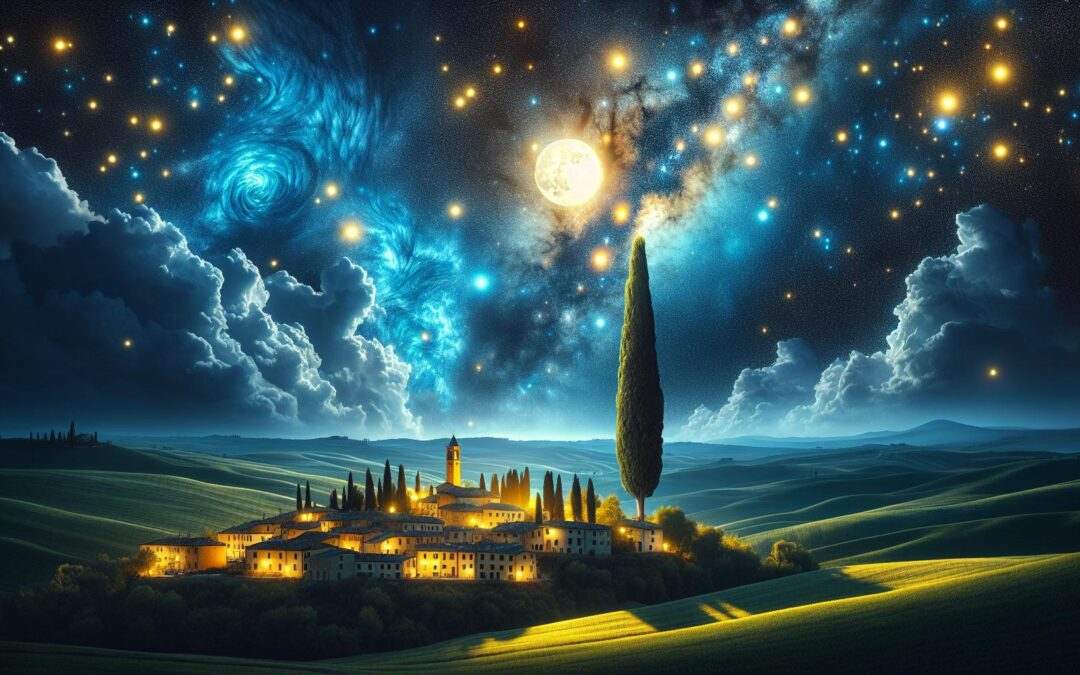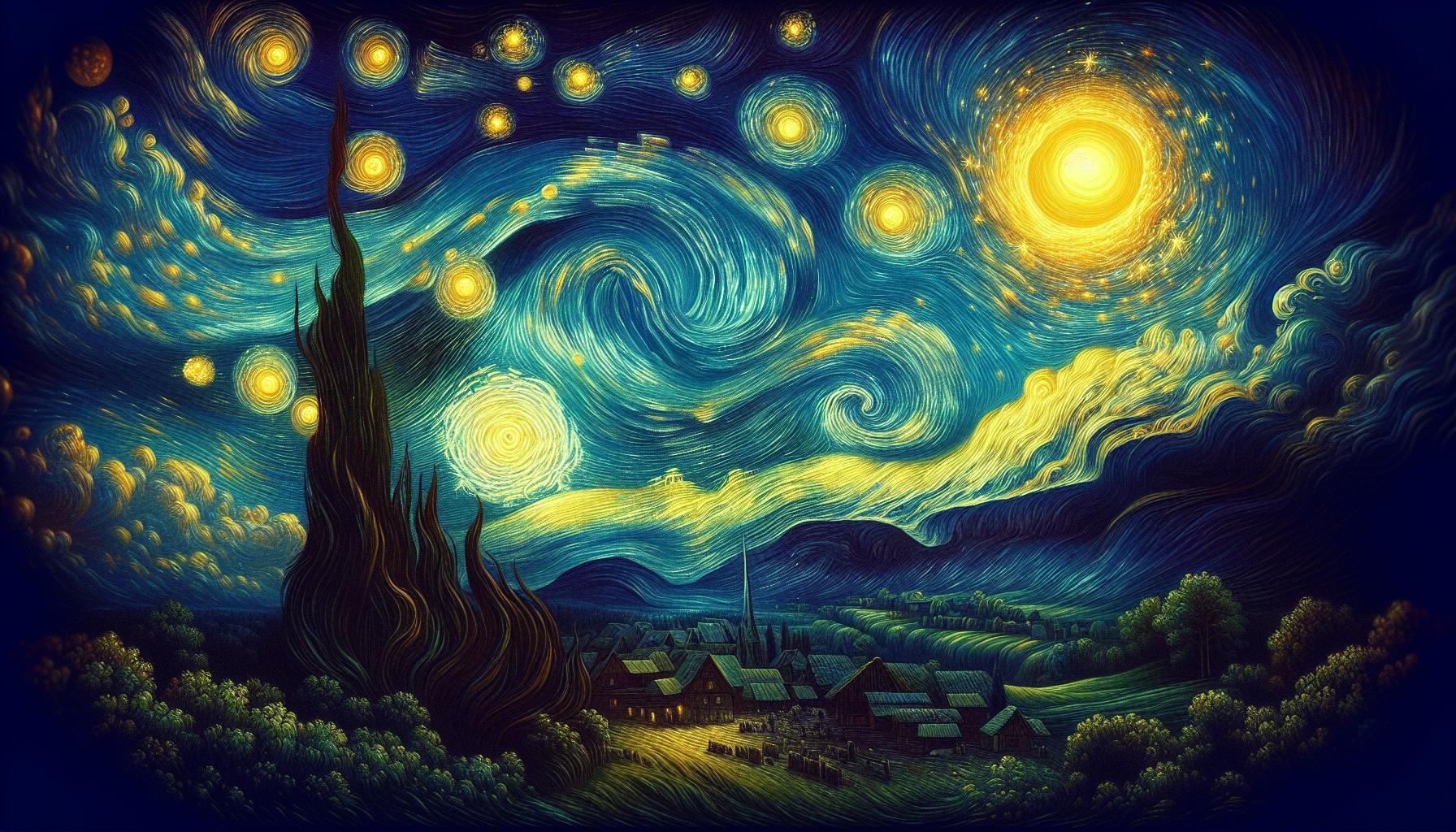Vincent van Gogh’s “Starry Night” captivates viewers with its swirling skies and vibrant colors, making it one of the most celebrated masterpieces in art history. This iconic painting not only showcases the artist’s unique style but also serves as a rich tapestry of artistic elements that convey emotion and depth. Understanding these elements can unlock new appreciation for Van Gogh’s vision and technique. From the dynamic use of line and color to the interplay of light and shadow, “Starry Night” is a perfect example of how art can evoke feelings and stimulate the imagination. Each brushstroke tells a story, inviting observers to explore the night sky alongside the artist. Delving into the elements of art within this work reveals the intricate layers that contribute to its timeless allure.
Starry Night Elements of Art
Vincent van Gogh’s “Starry Night” features a night sky filled with swirling clouds, bright stars, and a glowing moon, creating a vivid celestial landscape. The painting’s rich blue hues dominate the canvas, with contrasting yellows and whites highlighting celestial bodies. Van Gogh utilizes dynamic lines to create movement, drawing the viewer’s eye across the scene. The village in the foreground provides grounding, illustrating the harmony between nature and human existence. The cypress tree, which extends upward toward the sky, symbolizes a connection between the earth and the heavens. This interplay of elements fosters a sense of depth and invites contemplation. Van Gogh’s brushwork exemplifies the post-impressionist style, emphasizing emotion and expression over realism. The rhythmic application of paint adds texture and life, further enhancing the artwork’s visual impact. Each stroke contributes to the overall atmosphere, encapsulating Van Gogh’s emotional state and artistic vision.
Ultimately, “Starry Night” serves as a testament to the power of art to evoke feelings and inspire reflection, showcasing Van Gogh’s innovative approach and profound understanding of color and form.
Color in Starry Night
Color plays a pivotal role in Vincent van Gogh’s “Starry Night,” dramatically shaping the painting’s mood and impact. It highlights the interactions between natural elements and human emotion.
Use of Blue and Yellow
Blue dominates the canvas, creating a sense of depth and tranquility. Van Gogh employs various shades, from deep navy to lighter cerulean, to convey the vastness of the night sky. Yellow introduces warmth and vibrancy, particularly evident in the luminous stars and moon. This juxtaposition of blue and yellow fosters a visual tension that energizes the composition, inviting viewers to engage with the scene.
Emotional Impact of Color Choices
Van Gogh’s color choices evoke strong feelings. The cool blues suggest calmness and solitude, while the bright yellows symbolize hope and joy. Together, these colors encapsulate the emotional duality of the night—a blend of serenity and connection. The interplay between warm and cool tones reflects Van Gogh’s introspective nature and his struggle with mental health, adding a layer of complexity to the viewer’s experience.
Line and Movement
The use of line and movement in “Starry Night” plays a crucial role in conveying emotion and engaging the viewer. Van Gogh expertly incorporates swirling lines and dynamic patterns that produce rhythm and energy throughout the artwork.
Swirling Lines and Patterns
Swirling lines characterize the sky in “Starry Night.” Each stroke captures movement, creating a sense of fluidity. These lines draw the viewer’s eye across the canvas, enhancing the feeling of a dynamic night sky. The cypress tree’s flowing form mirrors the celestial swirls, further uniting elements within the composition. The patterns established by these lines create visual interest, enriching the overall aesthetic. Van Gogh’s technique emphasizes the contrast between the chaotic sky and the serene ground, reinforcing the emotional complexity of the piece.
Sense of Motion in the Artwork
A palpable sense of motion permeates “Starry Night.” The swirling clouds and bright stars convey an impression of a living, breathing universe. This movement invites viewers to feel immersed in the scene, as if they, too, are experiencing the night sky’s vibrant energy. Van Gogh’s brushwork enhances this effect, with energetic strokes that capture both chaos and serenity. The juxtaposition of movement in the sky and stillness in the village grounds the composition, creating a compelling tension. This dynamic interplay evokes introspection, allowing viewers to connect with the emotional landscape of the painting.
Texture and Brushwork
Van Gogh’s “Starry Night” features distinct texture and brushwork that enhance the painting’s emotional depth and visual interest. The application of paint creates a tactile quality, drawing the viewer into the artwork’s dynamic atmosphere.
Impasto Technique
Van Gogh employs the impasto technique throughout “Starry Night.” This method involves applying thick layers of paint, allowing brush strokes to remain visible. The raised texture heightens the painting’s vibrancy and creates a sense of movement. For instance, the swirling skies, laden with heavy strokes, contribute to an overall feeling of energy and dynamism. This texture invites viewers to explore the materiality of the paint, engaging them with the physicality of Van Gogh’s artistic process.
Texture’s Role in Visual Experience
Texture plays a pivotal role in shaping the visual experience of “Starry Night.” It amplifies emotional responses by contrasting the vibrant, swirling sky with the smoother surfaces of the village below. The textured brushwork simulates the play of light and shadow, enhancing spatial depth. This interplay not only captivates the eye but also reinforces the painting’s themes of turbulence and tranquility, inviting a deeper emotional connection. Through the careful manipulation of texture, Van Gogh transforms a simple night scene into a rich tapestry of feeling and expression.
Form and Shape
Form and shape constitute fundamental elements in Vincent van Gogh’s “Starry Night,” shaping the viewer’s perception and experience of the artwork.
Depiction of the Sky and Landscape
The sky in “Starry Night” features bold and curvilinear shapes representing swirling clouds and bright celestial bodies. Van Gogh uses large, rounded forms, such as the illuminated moon and the spiraling stars, to create a sense of movement and rhythm. These dynamic shapes contrast sharply with the more structured, rectangular forms of the village below. The landscape presents a grounded stability while the sky conveys a sense of fluidity and transformation. This juxtaposition enhances the interplay between chaos and serenity, allowing viewers to engage with the contrasting elements present in their own experiences.
Interpretation of Shapes in Starry Night
Shapes in “Starry Night” invite varied interpretations, reflecting Van Gogh’s emotional state and thematic intentions. The cypress tree, with its tall, slender form, stretches upward, symbolizing a connection between the earth and the heavens. This vertical shape contrasts with the horizontal lines of the village, emphasizing the connection between humanity and nature. Stars and moon exhibit circular shapes that prompt feelings of wonder and contemplation. Together, these forms establish a balanced yet dynamic composition, reinforcing the themes of introspection and the vastness of the universe. The shapes evoke a sense of harmony amidst disorder, showcasing Van Gogh’s innovative approach to spatial organization and emotional expression. “Starry Night” stands as a profound exploration of emotion and artistic innovation. Its swirling skies and vibrant colors not only captivate the eye but also invite viewers to reflect on their own experiences. The interplay of line, color, and texture creates a dynamic composition that resonates deeply with the human spirit. Van Gogh’s ability to blend chaos with serenity offers a unique lens through which to appreciate the complexities of life and nature. This masterpiece continues to inspire and evoke feelings, reminding us of the transformative power of art.


